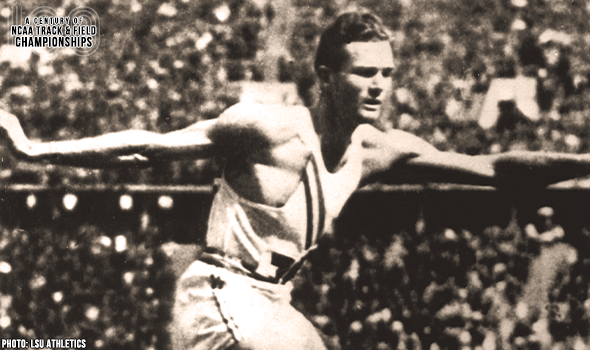
LSU’s Hardin Completed Unique 440-220H Double Twice
Glenn Hardin of LSU had a debut never seen before at the 1933 NCAA Outdoor Track & Field Championships at Chicago’s Soldier Field.
Hardin was just a sophomore when he entered an unlikely combination of events, the 440 yards and 220-yard hurdles. Hardin owned the year’s world-leading performances in both events, and his unique background meant running both – and well – on the same day was possible.
The LSU standout owned the world record and Olympic silver medal in the 400-meter hurdles, an event that was still a few years away from being offered on the NCAA’s championship menu. He earned the WR and medal the previous summer at the Los Angeles Olympics (the gold medalist’s time wasn’t eligible then for a record because of a knocked-over hurdle).
The closest call for Hardin in the NCAA meet came in the 440, but his meet-record 47.1 was a new world-leading mark and just held off Ivan Fuqua of Indiana and Ed Ablowich of Southern California. The previous summer Fuqua and Ablowich ran the opening two legs of the gold-medal winning U.S. 4×400 relay team at the Los Angeles Olympics.
Less than an hour later, Hardin was back on the track, skimming over the 220 hurdles – 6 inches lower than the 400 intermediates – in 22.9 to match his own world-leading time. Both of Hardin’s 22.9 times were faster than the ratified world record of 23.0 at the time, but neither received official recognition.
Hardin’s team-high 20 points were important for LSU, which would end up winning the team crown by four points in an upset over USC. You might also remember that Matt Gordy notched a walk-off victory in the pole vault to give the Tigers the decisive margin.
The 1934 season saw more of the same uniqueness from Hardin, except that the man known as “Slats” was even faster (He gained the nickname in high school because he was so tall and thin, like the slats for a bed).
Though Fuqua gained an early-season victory on Hardin’s home track in a dual meet, Hardin came through with another NCAA meet record as the meet moved away from Chicago for the first time. Running again at the Los Angeles Memorial Coliseum, Hardin won the 440 in 47.0, and no one was close in the 220 hurdles as he lowered the world best to 22.7 (again unratified).
Hardin proved most formidable in the 400-meter hurdles during the summer of 1934, lowering his world record to 50.6, a mark that would stand for 19 years.
His collegiate career ended in 1935 after another remarkable effort at the NCAA Outdoor Championships, but this time he found his match in each event. Hardin finished third in the 440 (UCLA’s Jimmy LuValle won) and runner-up in the 220 hurdles to Jesse Owens of Ohio State.
As a post-collegian in 1936, Hardin won Olympic gold in the 400 hurdles in Berlin. By 1964, the 400H was regularly on the NCAA schedule and his son Billy won the title for LSU, completing the meet’s first father-son combination of NCAA champions. Billy’s time, a meet-record 50.2, gave him the family best.
The NCAA and collegiate track & field will mark a momentous milestone in the spring of 2021 -- the 100th anniversary of the NCAA Championships and with that, the NCAA Track & Field Championships. In June 1921, the University of Chicago hosted the first track & field championships in NCAA history.
This point can’t be emphasized enough: Not only was the event the first for NCAA track & field, but the first championships for any sport under the sponsorship of the NCAA.
To celebrate, over each of the next 365 days, the U.S. Track & Field and Cross Country Coaches Association (USTFCCCA) will celebrate moments, student-athletes, and coaches that have made a century’s worth of championships special. From humble beginnings to important historical milestones to the modern-day, collegiate track & field has evolved with the American society.
The 2021 edition of the NCAA Division I Outdoor Track & Field Championships begin with preliminary round action on May 27-29 in Jacksonville, Fla., and College Station, Texas. The championships final site and culmination of the celebration is slated for June 9-12, 2021 at the newly rebuilt Hayward Field in Eugene, Ore.

Lawson Completed “Jesse Owens Triple” In 2016
Jarrion Lawson won the 100, 200 and long jump at the 2016 NCAA Division I Outdoor Track & Field Championships.

Plab Reached Lofty Heights In NCAA HJ
Darrin Plab won back-to-back HJ titles at the NCAA DI Outdoor T&F Championships in 1991 & 1992. Plab cleared 2.34m (7-8) in 1992 & tied the 2nd best bar in meet history.
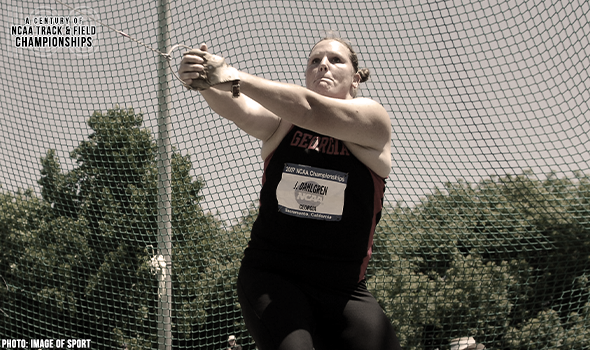
Dahlgren Won Back-To-Back HT Titles, Set MR
Jenny Dahlgren won back-to-back hammer titles at the NCAA DI Outdoor T&F Championships in 2006 & 2007. Dahlgren set a MR of 70.72m (232-0) in that second year.

Peoples Made History One Lap At A Time
Maurice Peoples won the 440-yard dash in 1973 & then really turned up the heat. Peoples split 43.4 on the Sun Devils’ mile relay team that finished third in the final.
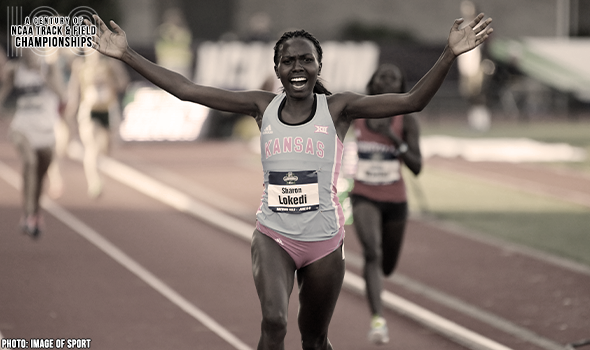
KU’s Lokedi Set 10K MR In 2018
Sharon Lokedi won the 10K at the 2018 NCAA DI Outdoor T&F Championships in a meet-record 32:09.20. Lokedi led five other women under the old final-site best, too.
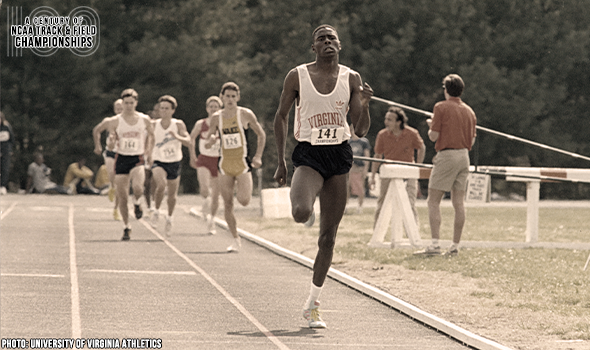
Can Ereng Kick It? Yes, He Can!
Paul Ereng won back-to-back 800-meter titles at the NCAA DI Outdoor T&F Championships in 1988 & 1989. Ereng is still the current indoor record holder in the event.
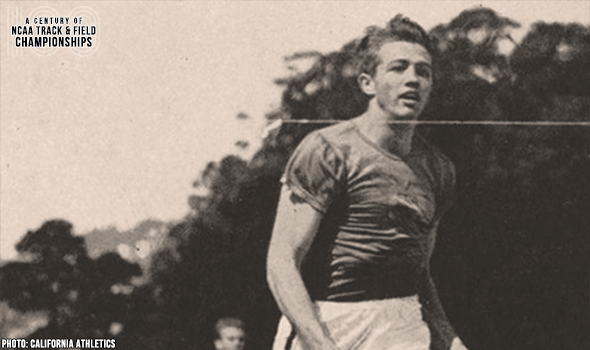
“California Comet” Doubled Up At NCAAs
Hal Davis completed the 100-200 double twice at the NCAA Outdoor Track & Field Championships.
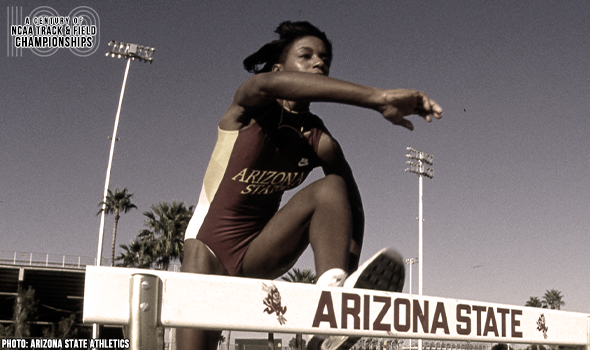
Tolbert Clocked 100H Meet Record In 1988
Lynda Tolbert won two career 100H titles at the NCAA DI Outdoor T&F Championships in 1988 & 1990. When Tolbert won in 1988, she set a MR of 12.82.
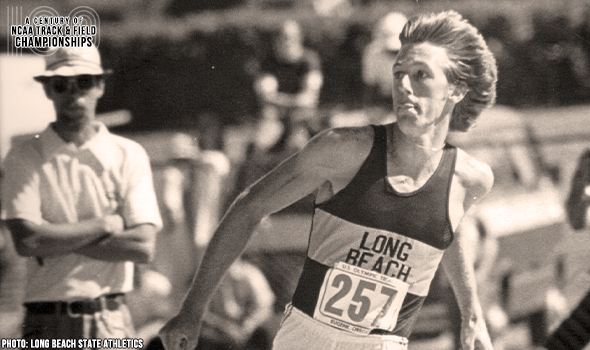
Dwight Stones Set High Jump WR In 1976
Dwight Stones set a world record in the high jump of 2.31m (7-7) at the 1976 NCAA DI Outdoor T&F Championships. Stones also raised the MR by more than 3 inches!
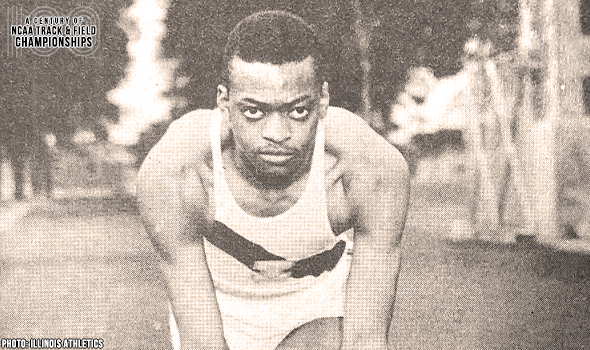
Walker Completed Only Hurdling Triple
George Walker is the only athlete in NCAA Outdoor T&F Championships history to win all three hurdling events: 110H (120H), 400H & now-defunct 220H.

